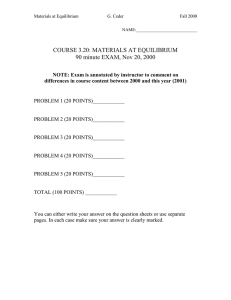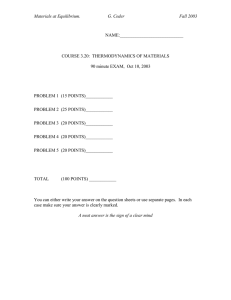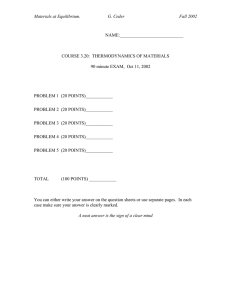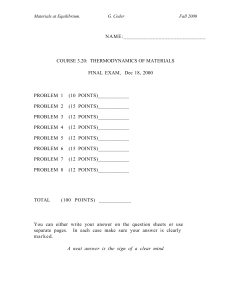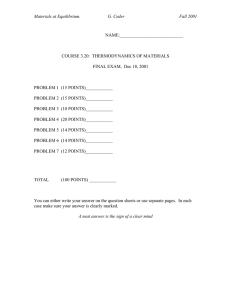Materials at Equilibrium. G. Ceder Fall 2002 NAME:____________________________
advertisement
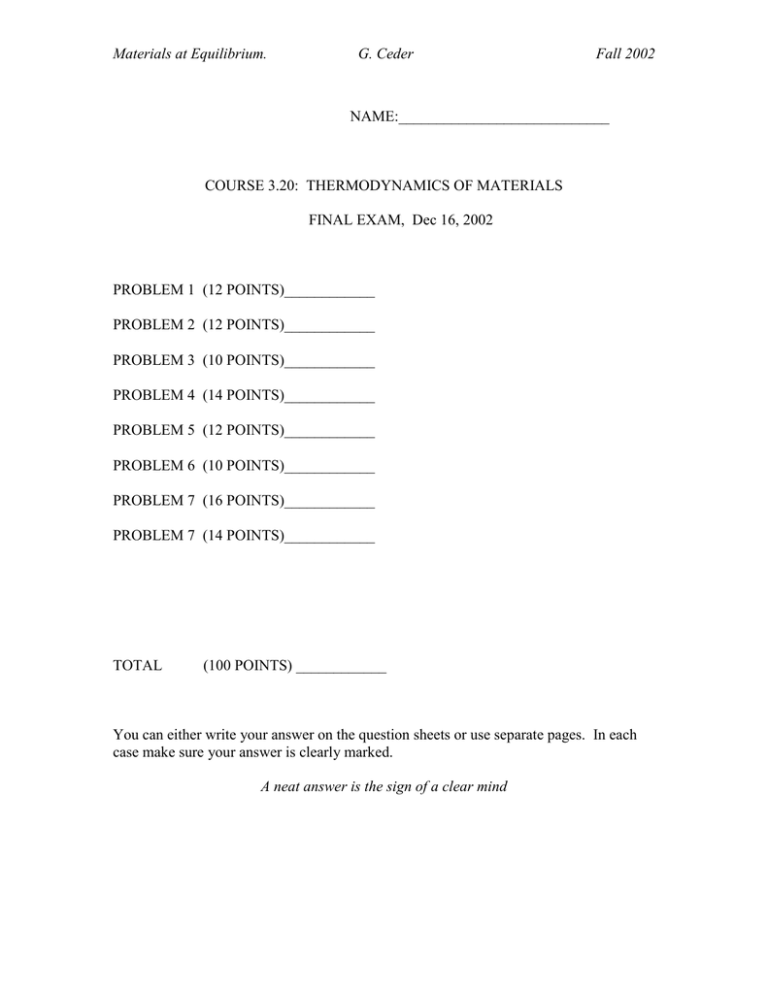
Materials at Equilibrium. G. Ceder Fall 2002 NAME:____________________________ COURSE 3.20: THERMODYNAMICS OF MATERIALS FINAL EXAM, Dec 16, 2002 PROBLEM 1 (12 POINTS)____________ PROBLEM 2 (12 POINTS)____________ PROBLEM 3 (10 POINTS)____________ PROBLEM 4 (14 POINTS)____________ PROBLEM 5 (12 POINTS)____________ PROBLEM 6 (10 POINTS)____________ PROBLEM 7 (16 POINTS)____________ PROBLEM 7 (14 POINTS)____________ TOTAL (100 POINTS) ____________ You can either write your answer on the question sheets or use separate pages. In each case make sure your answer is clearly marked. A neat answer is the sign of a clear mind Materials at Equilibrium. G. Ceder Fall 2002 Question 1: Consider a closed system at constant volume composed of a very large number N of distinguishable subsystems which do not interact with each other upon forming the larger system. The subsystem can only be in one of two energy states: E = 0, or E = ε. a) What is the maximum possible value of the energy per subsystem (Etot/N) when the system is in equilibrium (at any thermodynamic condition) ? b) In this condition of maximum energy, what is the entropy of the total system (Stot/N) ? c) Sketch the heat capacity, CV, of the system as function of temperature. Pay particular attention to limiting values (e.g. what is the value of the heat capacity at T = 0 and how is that value approached; value at high temperature, etc.) Materials at Equilibrium. G. Ceder Fall 2002 Question 2: One mole of a diatomic ideal gas initially having a volume of 1 liter and temperature of 800 K is made to undergo a three step cycle: 1 -> 2 reversible isothermal expansion to a volume of 2 liters 2-->3 reversible adiabatic compression to the original volume of 1 liter 3-->1 reversible (heating or cooling) at constant volume to the original temperature of 800 K. a) draw the reversible paths of this cycle on a P-V diagram b) calculate the values of P and T at states 1, 2 and 3 c) calculate the change in entropy of the gas along each path d) Assume now that the adiabatic compression from 2-->3 (i.e. from 2 liters to 1 liter) had occurred irreversibly. Would we end up with a higher or lower pressure P3 than the one calculated in part (b) after the reversible adiabatic compression? DATA: Cp for the gas is 7/2 R; CV is 5/2 R; ∆Hevap = 20 kJ/mole Materials at Equilibrium. G. Ceder Fall 2002 Question 3: The natural variables for the Helmholtz free energy, F, are V and T, giving the differential of dF a particularly simple form when written in terms of dV and dT. Write the differential dF in terms of variations in T and p. Do not leave any partial differentials in the expression for dF, but express everything in terms of properties or state functions (Cp, Cv, U, H, S, …) Materials at Equilibrium. G. Ceder Fall 2002 Question 4: Do not draw more than one solution. Clearly specify your answer Below is the Mn-Mo phase diagram. a) The phase boundaries in the area that is circled (near 2220oC) are somewhat unclear. Please draw a possible (but thermodynamically correct) solution for the three-phase equilibria near 2220oC showing clearly how all single phase regions connect to the invariant three-phase equilibrium. If necessary, exaggerate, the width of single phase regions. Please do not draw on the phase diagram, but make a clear drawing below. You do not need to draw the complete phase diagram, only the relevant section involving Mo,G and L near 2220oC. Do not yet worry about the hashed rectangle, which is for part b of the question. Materials at Equilibrium. G. Ceder Fall 2002 b) Your advisor spilled beer over part of the phase diagram, and as a result the region that is hashed on the previous page became illegible. On the diagram, below, please sketch a plausible solution for the missing region. Materials at Equilibrium. G. Ceder Fall 2002 Question 5: Y2O3-ZrO2 is a material of interest for sensors and solid oxide fuel cells. At the relevant temperature and composition range ZrO2 forms a simple fluorite structure with an fcc array of Zr cations, and the oxygen ions occupying all the tetrahedral interstitials of this array. As Y2O3 is added to ZrO2, the Y cations substitute on the Zr sublattice. For charge compensation reasons, a vacancy needs to exist on the oxygen sublattice for each 2 Y cations added a) Assuming an ideal solution of Y and Zr on the cation sublattice, and oxygen and vacancies on the anion sublattice, write down the entropy of mixing as function of the mole fraction of Y cations on the cation sublattice. b) In the real material, oxygen vacancies may be attracted to the Y cation, for electrostatic reasons or due to size effects. Describe how the entropy in part a) will change when such attractive interaction occurs. Materials at Equilibrium. G. Ceder Fall 2002 Question 6: Pure A melts at T=1000 K while pure B melts at T=1750 K. An fcc solid solution of A and B can be modeled with a regular solution model with enthalpy of mixing: ∆Hmix= – 12,600 XA XB in J/mol (XA is the mole fraction of A and XB is the mole fraction of B). Calculate the heat that evolves upon mixing 3 moles of pure liquid A with 7 moles of pure solid B at T=1200 K. It is observed that the final equilibrium state is a solid solution on the fcc lattice. ∆Hmelt=4 kJ/mol for pure A ∆Hmelt=7 kJ/mol for pure B ∆CP (Liquid – solid) = 0 J/mol K for pure A ∆CP (Liquid – solid) = 2 J/mol K for pure B Materials at Equilibrium. G. Ceder Fall 2002 Question 7 (Short questions): a) Define the Legendre transform of the entropy that gives a function with natural variables 1/T and p/T. b) A material (closed system) at constant pressure undergoes a reversible phase transition with temperature at T = T0. Please indicate whether the following statements are always true, true only part of the time, or never true. At the phase transition temperature the high temperature phase has a higher volume than the low-temperature phase: ______NEVER TRUE _____ALWAYS TRUE _____TRUE PART OF THE TIME At the phase transition temperature T0. the high temperature phase has a higher entropy than the low-temperature phase: ______NEVER TRUE _____ALWAYS TRUE _____TRUE PART OF THE TIME At the phase transition temperatureT0 the high temperature phase has a higher enthalpy than the low-temperature phase: ______NEVER TRUE _____ALWAYS TRUE _____TRUE PART OF THE TIME At the phase transition temperatureT0 the high temperature phase has a higher Gibbs free energy than the low-temperature phase: ______NEVER TRUE _____ALWAYS TRUE _____TRUE PART OF THE TIME c) A metal always has a higher electronic entropy than an oxide ______TRUE _____FALSE Materials at Equilibrium. G. Ceder Fall 2002 d) For a system with only pdV work, in an environment under constant pressure and temperature, the condition that ∆Suniverse > 0 is equivalent to: ______∆G > 0 ______∆G < 0 _____∆H < 0 _____∆H > 0 ______∆S < 0 _____∆S > 0 In the above, the state functions (G,H,S) refer to properties of the system. e) At constant composition, does the free energy increase or decrease with increasing temperature? _______INCREASE ________DECREASE Materials at Equilibrium. G. Ceder Fall 2002 Question 8: Two crystallographic phases α and β coexist at temperature T. The α phase is insoluble to B atoms and is made up exclusively of A atoms. The β phase consists of both A and B atoms. Assume that the atoms in the α and β phases can be modeled as atoms on a lattice that do not interact with their neighbors, but independently vibrate around the equilibrium positions with the following characteristic frequencies: νAα for A atoms in the alpha phase leading to a single-particle partition function qAα νAβ for A atoms in the beta phase leading to a single-particle partition function qAβ νBβ for B atoms in the beta phase leading to a single-particle partition function qBβ∴ a) Write an explicit expression for the single-particle partition function qAα in terms of the vibrational frequency νAα. b) Derive an expressions for the free energies of α and β in terms of the single particle partition functions. c) Write an expression for the solubility limit of A in β.
